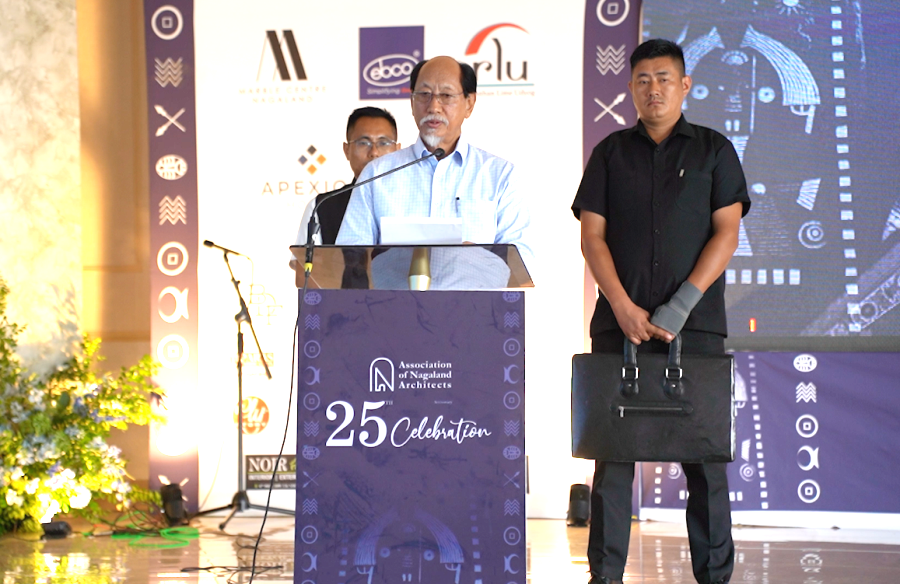CM Neiphiu Rio calls construction Nagaland’s biggest employment driver, urges architects to lead sustainable, safe, and inclusive development.
Share

DIMAPUR — Chief Minister Neiphiu Rio on Saturday said that the construction sector is the largest engine of employment in Nagaland, providing livelihoods to thousands of youth.
The chief minister was addressing the 25th anniversary celebration of the Association of Nagaland Architects (ANA) held at JP Park & Banquets, Chümoukedima.
“This presents a tremendous economic opportunity. As we build, we must also build capacity. I call upon ANA and its members to take a lead role in encouraging and training our local people. Introduce them to new technologies, modern construction techniques, and sustainable practices,” Rio said.
“By empowering our local masons, engineers, and artisans, you are not just constructing buildings; you are constructing careers and strengthening our economy.”
He maintained that architects are more than just designers of buildings—they are the custodians of heritage, interpreters of culture, and visionaries of the future.
“Every structure you design, every space you plan, contributes to the identity of Nagaland. You weave the tapestry of our traditional Naga ethos with the threads of modern functionality, creating a built environment that is both unique and relevant,” the chief minister said.
WATCH MORE:
Affirming that the government of Nagaland acknowledges and values the contributions of architects, Rio said their advocacy for a resilient and sustainable-built environment aligns perfectly with “our vision for a prosperous and responsible Nagaland.”
“As we celebrate this journey, we must also look ahead to the challenges and opportunities that define our times. And here, I wish to place before you a dual responsibility—one that is both a challenge and an opportunity,” he said.
“First, we live in Earthquake Zone 5. This is not a statistic in a manual; it is a reality that governs our lives. It demands not just compliance, but ingenuity. It calls upon you, our architects, to be at the forefront of innovation.”
He urged architects to continuously seek and champion new and innovative solutions that are not just fundamentally or aesthetically pleasing, but also uncompromisingly safe.
Also read: Nagaland, NE states to benefit from proposed bamboo development project
“This brings me to a critical social imperative—the need for low-cost housing solutions. A safe and dignified home is the right of every citizen. The challenge is to make this a reality, especially in our hilly terrain and given our economic constraints,” Rio said.
“I urge you to apply your brilliant minds to this problem. Can we innovate with local materials? Can we design modular, affordable, yet earthquake-resistant homes? Can we create models that can be replicated across our villages and towns? This is where your expertise can bring about a transformative social change,” he added.
On the occasion, Rio also inaugurated the exhibition stalls and unveiled the jubilee magazine.
Dr. Gauri Nitin Shiurkar, member of the Council of Architecture of India, in her speech, described Nagaland’s architecture as a true reflection of its people—resilient, rooted, and expressive.
Read more: A blend of Naga and Japanese design: Eco Park nears completion in Kohima
The traditional Naga morungs, with their intricate carvings and profound symbolism, she noted, are more than structures; they embody community, identity, and collective wisdom.
Shiurkar highlighted the natural sustainability ingrained in Naga architecture—the thoughtful use of bamboo, timber, and stone that respects climate, terrain, and traditional craftsmanship.
Long before “green architecture” became a global concept, Nagaland was already living it naturally, intuitively, and beautifully, she said.
She observed that a new generation of architects is now blending the wisdom of the past with the aspirations of the future, an evolution that preserves the soul of Naga design. Amidst the rise of artificial intelligence, virtual modelling, and parametric design, she reminded that while technology may draw the lines, it is humanity that gives them meaning.
For Nagaland, she said, opportunities abound in ecotourism, rural development, and infrastructure—areas where architects can play a pivotal role in shaping the region’s sustainable future.
With its deep connection to culture and environment, Nagaland can emerge as a beacon of regional and sustainable architecture, which is rooted, relevant, and revolutionary, she added.
Addressing young architects and students, she reminded them that architecture is both a challenge and a privilege, demanding patience, creativity, and perseverance, yet offering immense fulfilment when ideas take form.
Shiurkar further urged the younger generation to preserve their unique identity while engaging with the modern world. The global community, she added, now looks to regions like Nagaland for lessons in contextual and ecological design—proof that sustainability often lies in time-honoured traditions rather than new technologies.